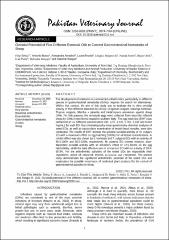Ovicidal Potential of Five Different Essential Oils to Control Gastrointestinal Nematodes of Sheep

View/
Date
2021Author
Štrbac, Filip
Bosco, Antonio
Amadesi, Alessandra
Rinaldi, Laura
Stojanović, Dragica
Simin, Nataša
Orčić, Dejan
Pušić, Ivan
Krnjajić, Slobodan
Ratajac, Radomir
Metadata
Show full item recordAbstract
The development of resistance to commercial anthelmintics, particularly in different
species of gastrointestinal nematodes (GINs), requires the search for alternatives.
Within that context, the aim of this study was to evaluate the in vitro ovicidal
activity of five different essential oils (EOs): Origanum vulgare, Satureja hortensis,
Thymus vulgaris, Mentha x piperita and Helichrysum arenarium against sheep
GINs. For this purpose, the nematode eggs were collected from naturally infected
sheep by GINs in two farms located in southern Italy. The egg hatch test (EHT) was
performed at six different concentrations (50, 12.5, 3.125, 0.781, 0.195 and 0.049
mg/mL) for each EO. Gas chromatography-mass spectrometry chemical analyses of
tested EOs, as well as coproculture examination of tested faecal samples, were also
conducted. The results of EHT showed the greatest ovicidal activity of O. vulgare
EO with a maximum effect on egg hatching (100%) for all tested concentrations. A
similar effect was also shown by S. hortensis and T. vulgaris EOs with an activity of
99.3-100% and 98.5-100%, respectively. M. piperita EO showed medium, dosedependent ovicidal activity with an inhibitory effect of 72.5-99.8% on the egg
hatchability, while the least effective was H. arenarium EO with an activity of 59.8-
69.3%. For the anthelmintic activities of the tested EOs are responsible their
ingredients, above all carvacrol, thymol, p-cymene and γ-terpinene. The present
study demonstrated the significant anthelmintic potential of the tested EOs and
emphasizes the possible importance of medicinal plant products for the control of
gastrointestinal parasites in sheep.
